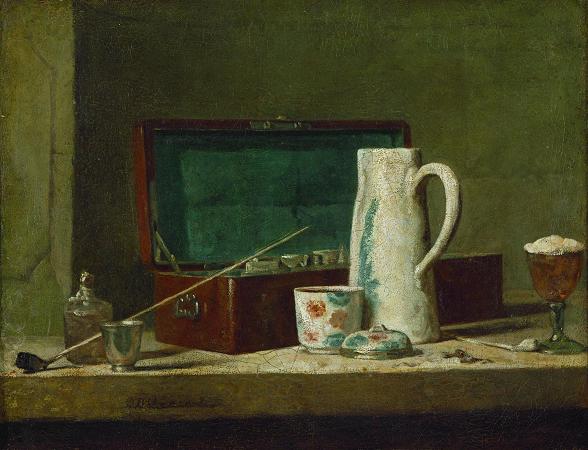Still Life with Tobacco. Tobacco has often been featured in still life paintings, either as loose leaves, bundles, or in the form of pipes and other smoking paraphernalia. These works often symbolize the fleeting nature of life or serve as a reminder of the wealth and trade brought about by the Age of Exploration. Many portraits depict individuals smoking pipes or holding tobacco-related objects, such as snuffboxes. These images often convey a sense of sophistication, wealth, or leisure, as tobacco was initially an expensive luxury item imported from the New World. Genre scenes: Scenes of everyday life often include depictions of people smoking or using tobacco in social settings. These works provide insight into the cultural practices and attitudes surrounding tobacco use during different time periods. Allegorical and symbolic representations: Tobacco has been used as a symbol in art to represent various concepts, such as the vices of excess or the dangers of addiction. In some cases, it has also been associated with the New World and the encounter between European and indigenous cultures. Colonial and postcolonial themes: Artworks related to the history of colonialism and its aftermath sometimes feature tobacco as a central element. These works may explore the exploitation of indigenous labor, the environmental impact of tobacco cultivation, or the role of tobacco in shaping global trade networks. Tobacco is the common name of several plants in the genus Nicotiana of the family Solanaceae, and the general term for any product prepared from the cured leaves of these plants. More than 70 species of tobacco are known, but the chief commercial crop is N. tabacum. The more potent variant N. rustica is also used in some countries. Dried tobacco leaves are mainly used for smoking in cigarettes and cigars, as well as pipes and shishas. They can also be consumed as snuff, chewing tobacco, dipping tobacco, and snus. Tobacco contains the highly addictive stimulant alkaloid nicotine as well as harmala alkaloids. Tobacco use is a cause or risk factor for many deadly diseases, especially those affecting the heart, liver, and lungs as well as many cancers. In 2008, the World Health Organization named tobacco use as the world's single greatest preventable cause of death. According to Iroquois mythology, tobacco first grew out of Earth Woman's head after she died giving birth to her twin sons, Sapling and Flint. Tobacco has long been used in the Americas, with some cultivation sites in Mexico dating back to 1400–1000 BC. Many Native American tribes traditionally grow and use tobacco. Historically, people from the Northeast Woodlands cultures have carried tobacco in pouches as a readily accepted trade item. It was smoked both socially and ceremonially, such as to seal a peace treaty or trade agreement. In some Native cultures, tobacco is seen as a gift from the Creator, with the ceremonial tobacco smoke carrying one's thoughts and prayers to the Creator. While western views on tobacco affirm its damaging effects on human health, ancestral views on the plant dissent. Shamanic views, as well as indigenous perspectives on the plant, insist on the sacrality of tobacco and its ritualistic usage as a spiritual and physical medicine. Some Native Americans consider tobacco to be a medicine and advocate for its respectful usage, rather than a commercial one. Indigenous communities have smoked tobacco leaves for thousands of years in order to heal diseases. Following the arrival of the Europeans to the Americas, tobacco became increasingly popular as a trade item. Francisco Hernández de Toledo, Spanish chronicler of the Indies, was the first European to bring tobacco seeds to the Old World in 1559 following orders of King Philip II of Spain. These seeds were planted in the outskirts of Toledo, more specifically in an area known as "Los Cigarrales" named after the continuous plagues of cicadas. Before the development of the lighter Virginia and white burley strains of tobacco, the smoke was too harsh to be inhaled. Small quantities were smoked at a time, using a pipe like the midwakh or kiseru, or newly invented waterpipes such as the bong or the hookah. Tobacco became so popular that the English colony of Jamestown used it as currency and began exporting it as a cash crop; tobacco is often credited as being the export that saved Virginia from ruin.
more...









